Today I’m calling Cao Fei, the Beijing-based artist who works across film, digital media, photography, sculpture, installation and performance. She has a keen interest in documenting the social impact of technological developments over the last two decades. Cao Fei is interested in how the virtual world contradicts and coincides with reality, resulting in something ambiguous and complex. Her starting point is China and how people, especially young people, navigate the rapidly changing social and technological landscape. Cao Fei, thank you for joining me.
Cao Fei: Hi, Barbara.
[Continue reading for full transcript.]
Transcript
BL. Let’s start with Guangzhou, the city where you grew up. Your father, Cao Chong’en, is a highly acclaimed socialist-realist sculptor and a professor of drawing and sculpture at the Guangzhou Academy of Fine Art. As you were growing up in Guangzhou, where did you find inspiration?
CF. My parents both teach in Guangzhou Academy of Fine Art, and both are sculptors. That was the major inspiration for me to became an artist. Also, because Guangzhou is very near Shenzhen, the first open policy city just next to Hong Kong, that’s why a lot of Western culture, even pop culture, gave me a lot of inspiration during my childhood.
BL. I gather you watched MTV a lot. I’m curious, were the programs in Cantonese? In Japanese? Or were they from the U.S. and in English?
CF. Much of MTV was from the U.S. Even sometimes when we couldn’t get the MTV channel, we had VHS tapes that some young people had copied from the MTV channel. We watched Madonna, Michael Jackson, Prince … That was the very early kind of pop style, from the end of ’80s.
BL. There’s another thing I’m very curious about. Your background is very different from the art students studying video in Hangzhou. They were much more academic. They were looking into the work of Joseph Beuys and Nam June Paik. Unlike them, you were very much engaged with global pop, which could be Cantonese pop music, Japanese anime, American hip hop. There’s a quote I found, where you said that your early work was about freaking out. What did you mean by that?
CF. Firstly, I studied at the same school where my parents teach. The school at that time was more traditional than the China Academy of Fine Art in Hangzhou. We didn’t have contemporary art classes. Our school only talked about pop art. Can you imagine?
So, when I finished my first video work in 1999, I didn’t know anything about contemporary art, even contemporary art in China or the world of contemporary art. But I think I was quite lucky to be inspired by pop film culture, which is more than contemporary art, because I think non-contemporary art gave me more. The language is very different. It’s not from an academic art school; it’s a freer language from mass media.
BL. I understand that you worked briefly in advertising after art school—did that give you access to computers and software? And did that impact the path that you took?
CF. When I had just graduated, I did some part-time work for a TV advertising company. My role was more like an art director. I would be looking for material or costumes, even discovering what the make-up looks like. I’m glad to have had this experience, because I had more time to work with a team of people. Even the television director comes from commercial advertising—I could see how they used the camera, how they edited, how they directed the actors.
So that was my very beginning work. Sometimes I will take great care for lighting. Like today [on this Zoom call], I used lighting on my face. I think it was an artistic influence on me, like very fast editing. I use music all the time, and I think it relates to my advertising work experience.
BL. Around the same time that you and I met—I think it was in 1997 or a bit later—you and the writer-thinker Ou Ning were developing the documentary The San Yuan Li Project. It was a very carefully researched work about the changing landscape of San Yuan Li, a rural village within the city of Guangzhou. What were your objectives with that project?

Photo: Courtesy of the artists, Vitamin Creative Space, and Sprüth Magers
CF. At the end of 2002, we got an invitation to participate in the Venice Biennale, which Hou Hanru curated. San Yuan Li was like a city expanding; the village was far away from the city center of Guangzhou, so we wanted to see how the expansion would affect this kind of traditional village, how it would affect the local people and how the city will balance the village and modernization. Our project was to document these changes. We had many cameras, different digital video cameras, some not even good quality. We spent about half a year in the city documenting the different side of the city.
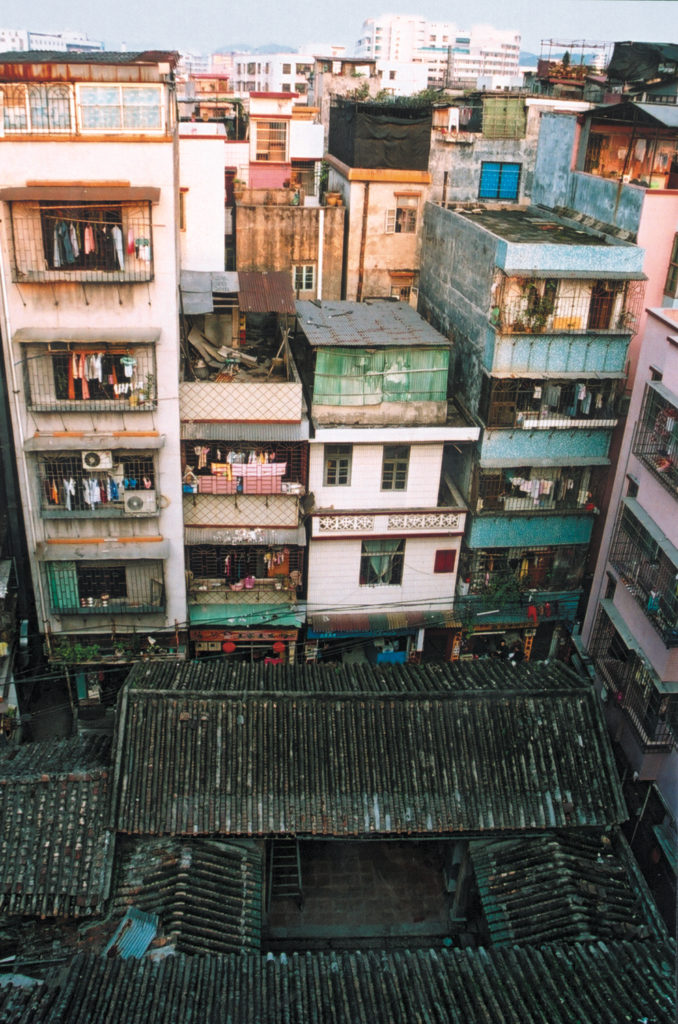
San Yuan Li is a kind of slum of the city, a kind of dark hole, which you couldn’t see from the outside in the beautiful, developing Guangzhou city. San Yuan Li is like a darkness of the city, so our mission was to discover this alternative area.
In our school books, San Yuan Li is a very important area. One hundred years ago the British came to China, and the San Yuan Li village people were anti-British at that moment. [Ed.—The British invaded China in 1840, defeating the Qing Dynasty in the Opium War.] After one hundred years, China was forced to open again, so it’s a kind of connection. After one hundred, the village was then forced to open to modernism.
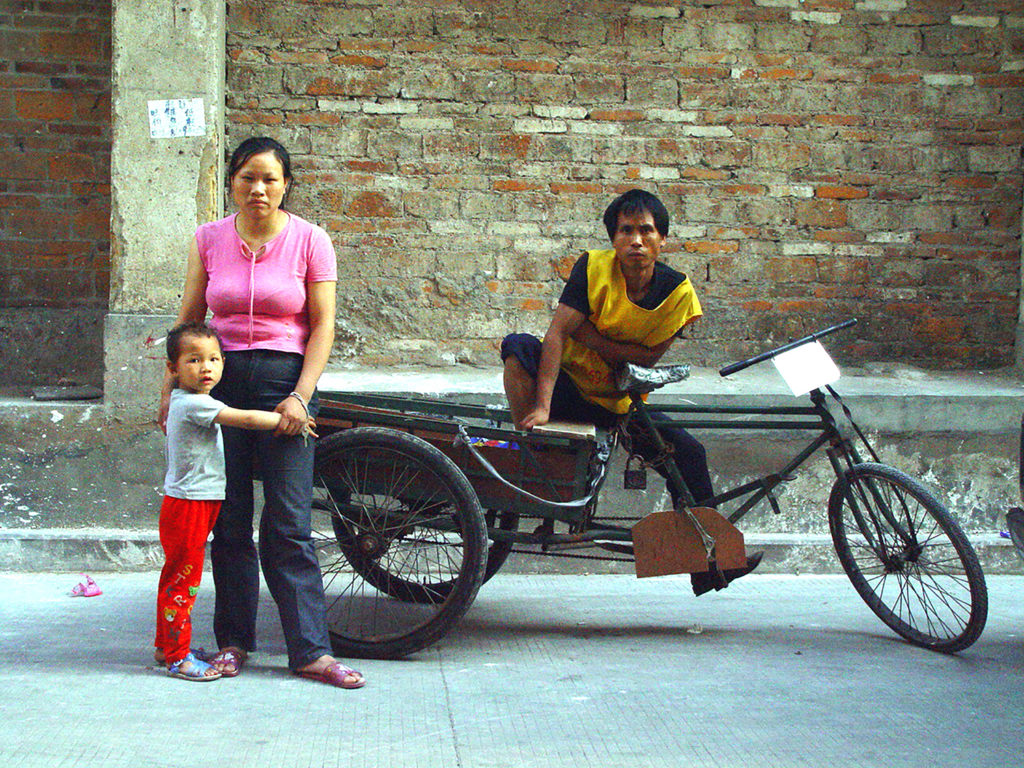
Photo: Courtesy of the artists, Vitamin Creative Space, and Sprüth Magers
BL. When we met in Beijing a few years later, you were working with Ou Ning on a very community-oriented documentary about another changing landscape, one at the heart of Beijing. That video was called Beijing Case: Culture of the High Speed Urbanism. What themes were you exploring in that piece?
CF. The project is called Beijing Case and the video is called Meishi Street (2006). Yes, like San Yuan Li, we focused on a location, on a village. Meishi is also a street’s name. Meishi Street is just in front of Tiananmen Square, only one kilometer from the power of the capital, Beijing. Because the city planners had to open a new road through this area [for the 2008 Beijing Olympics], the government decided to demolish the whole street, to expand and widen the street. That meant they needed to destroy a lot of hutong buildings. A hutong is a very typical old Chinese courtyard building.
We followed one of the citizens who lived on this hutong street. He was the last person who protected his home and protested against the local government. He argued with the government for many years. We decided to give him the camera to document his daily life, to show how he talked with the local government, and how he trained himself to be a kung fu man in order to protect his safety. We gave another two cameras to other people who followed his daily life. It’s a very interesting story.
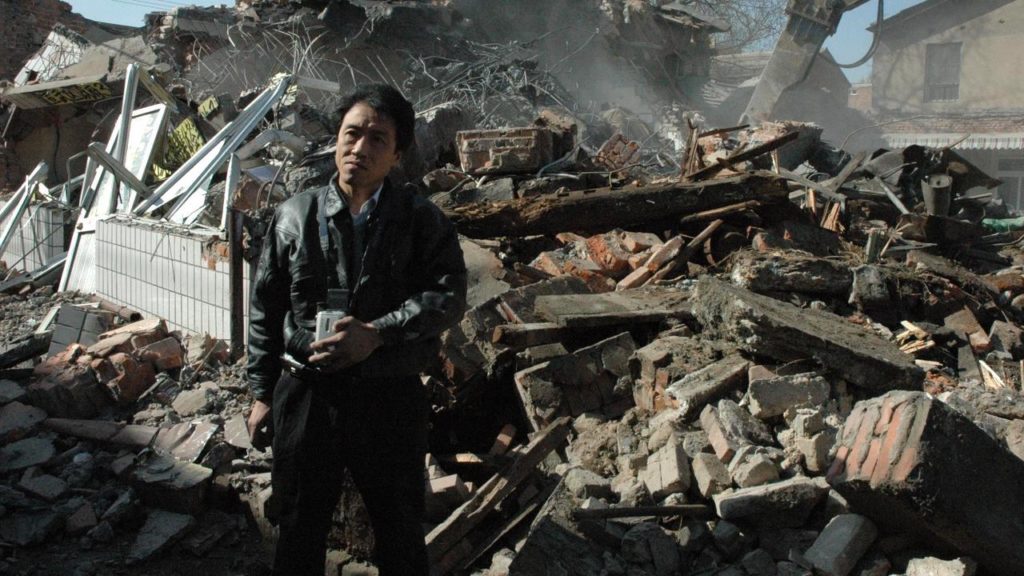
Meishi Street. 2006. Video (color, sound, 85 min.)
This piece continued the San Yuan Li Project as a group-working format. We worked long-term to follow a case, a group of people, a community, to look at how the urbanization in China affects the local community and breaks away from the traditional, first in Guangzhou and then later in Beijing.
BL. I’m curious, do you consider yourself an activist or an observer?
CF. I never give this title to myself, but people use these different kinds of words to [define] myself, which puts a different kind of credit or different layer to what we did.
BL. We can move on to your work of 2004 called Cosplayers, which is centered on young people who are casting themselves as fantastical video game characters. This is one of your major themes: the interplay between virtual and real worlds, utopia and dystopia, the body and technology. Did you play video games as child?
Cao Fei – Cosplayers (Trailer), 2004 from Sprüth Magers on Vimeo.
CF. Many people ask me, because they look at my work and see a lot of technology, but actually no. One day I was looking at a magazine and saw my friend dressed as a cosplayer on the cover of the magazine. I thought, “Oh, can you introduce your group of cosplayers to me, because I really want to follow them.” I thought this was very interesting. So I was able to follow them, something like the San Yuan Li and Meishi Street projects. But it’s not really, because San Yuan Li and Meishi Street are more documentary, with more realism; Cosplayers is half documentary and half dramatic.
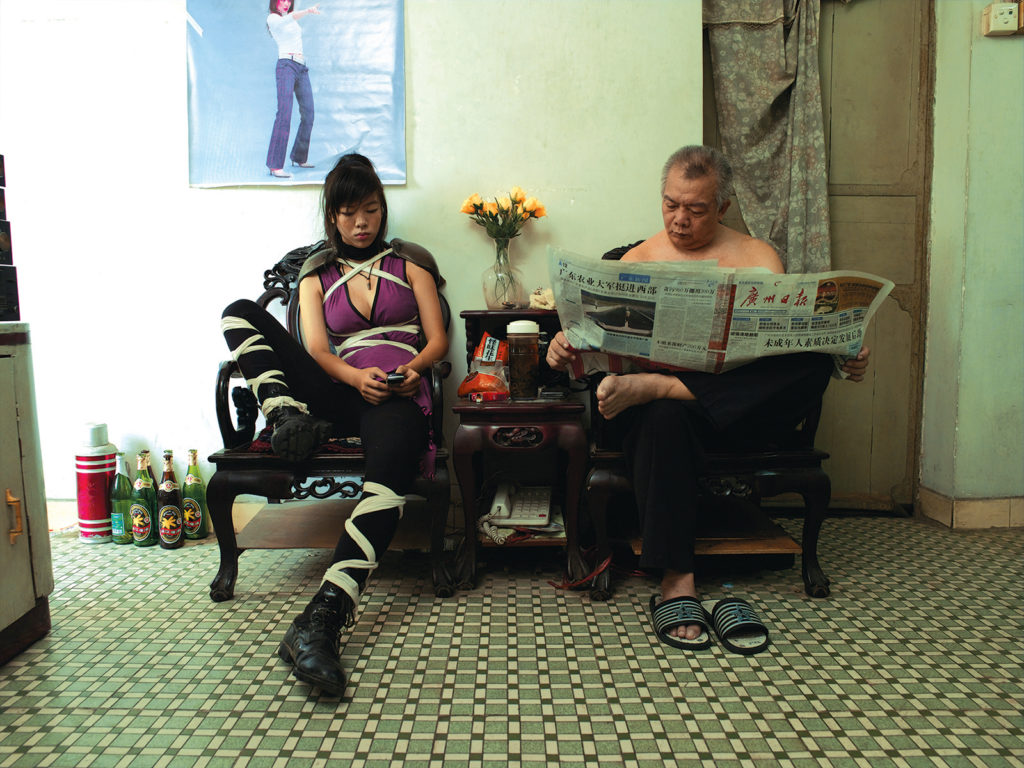
Single-channel video (color, sound, 9:12 min.)
Photo: Courtesy the artist, Vitamin Creative Space and Sprüth Magers
Also, you can see the documentary footage within the work. For example, when the cosplayer goes back home, they have dinner with their parents. When they take off their costume, sometimes it’s like the magic has lost its power. The players use the city like a game interface to play their imagination. I think that from the Cosplayers, I started to mix the dramatic more with documentary.
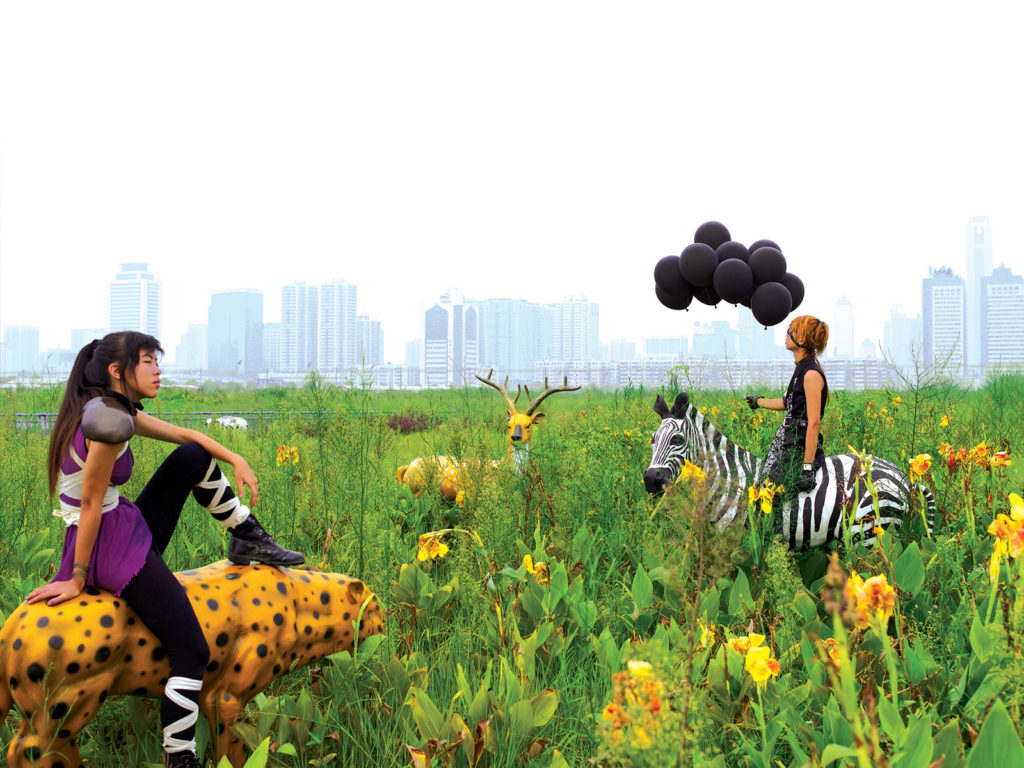
Single-channel video (color, sound, 9:12 min.)
Photo: Courtesy the artist, Vitamin Creative Space and Sprüth Magers
BL. I was fascinated to learn that you read and researched many of the labor reports about the situation in the Pearl River Delta, the mega city which includes the city of Foshan, and is now among the world’s largest urban areas in population and size. This research led to your next work, Whose Utopia? (2006), which you made during a six-month residency at the OSRAM lighting factory in Foshan, an industrial city just outside of Guangzhou. Whose Utopia? is in three parts, with shots that document the process of producing light bulbs in the factory, plus scenes of workers. There’s the wonderful sequence of a woman en pointe as a ballerina in the workspace.
You’ve said, “Factories are not a creative industrial park or Google office. Factories are cold production lines and large machines. They are pipelined environments; they are clean and tidy with no extra trace of garbage. They’re filled with tired people who repeat the same work day after day, in multinational groups. They are corporate systems—refined management and corporate culture that inspire the staff so they will not fall into desperate spirit.”
You were there for six months at the OSRAM factory. Could you tell me what it was like engaging with these workers? Were they your collaborators?
CF. At the end of 2005, the Siemens Art Project in China came to me to say they were interested in me for a new project. I already knew a lot of video artists—for example, Yang Fudong had already worked with Siemens Art Project in Shanghai. When they had a Guangzhou Siemens Art Project, they invited me to participate. I said, “Why not?”
I like reading the newspaper, I like to follow social media, so at that time, I knew about working conditions in the Pearl River Delta and what happened there. Everybody knows in China, production is mostly in the Pearl River Delta. But now it’s happening more in the Zhejiang area near Shanghai [in the Yangtze River Delta]. But twenty years ago, many products were made in Pearl River Delta. That’s where I lived, so I was really curious: What exactly were the workers doing in the factory?
I didn’t just believe the newspaper, because that is secondhand information. I really wanted to find what I could see through my artist’s eyes. So I decided to spend half a year working on the project. I didn’t believe one month or ten days would be enough time to catch information from the workers. I’m very lucky that the Siemens Art Project and the company locals cooperated. They let me take video in the factory, which normally isn’t allowed because of all the business secrets.
I gave out about five hundred questionnaires to the whole factory, and I got back about two hundred. Then I picked thirty-five people from this group who I felt had interesting answers. I let these thirty-five people form a group, a kind of workshop. I asked them, “What is art? How do you make an art installation?” I did a different workshop with these workers every week.
During the same time, also I was shooting a documentary of the factory from different angles, of different situations, in different production departments. After half a year, we were almost friends. We got to know each other. Now, fifteen years later, I’m still in contact with some of the workers. If you saw the footage in the video of a few people dancing or doing kung fu on the factory floor, at that time I was thinking about how to release the workers’ dreams—their real dreams in the factory.
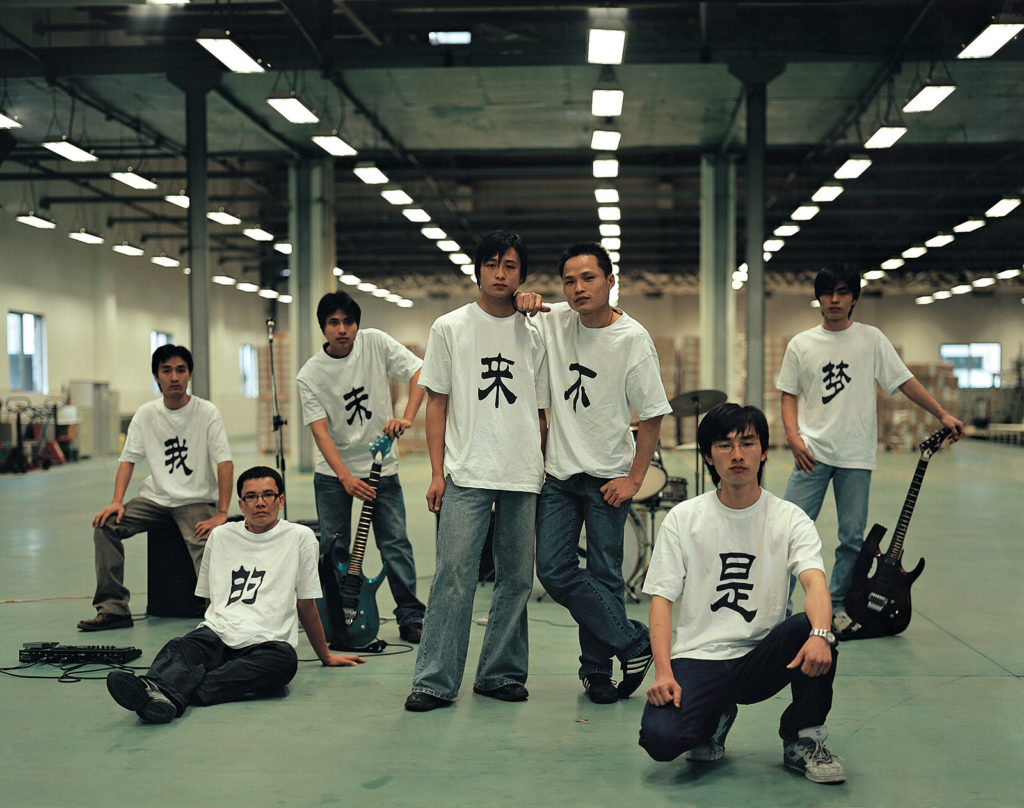
Actually, they couldn’t do anything else in the factory. But because they used my chance—used the “art chance”—I hoped they could tell me what they really want to be. Like the girl you see in the video, I asked her: “What do you really want to do?” And she said, “I want to be a dancer. I study a little bit of dance from TV. But because my home is very poor, all the money I earn I have to give my brother to study.”
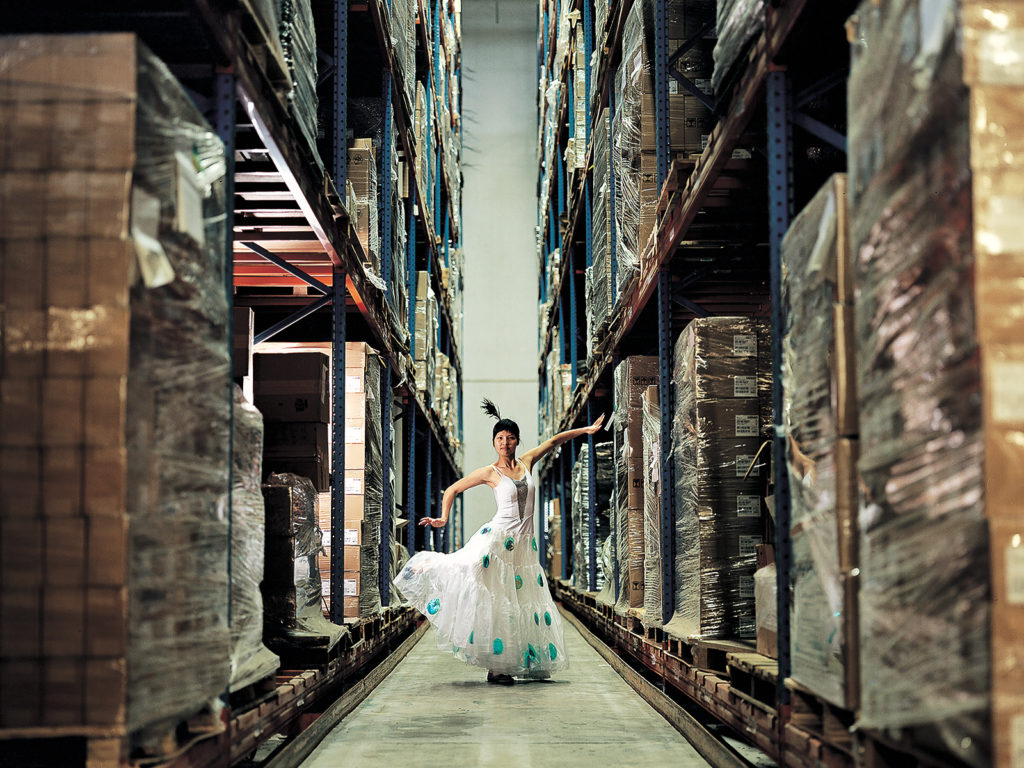
Single-channel video (color, sound, 20:20 min.)
Photo: Courtesy the artist, Vitamin Creative Space and Sprüth Magers
As you know, in China, females don’t have a position or chance to study at home. She’s very young, like sixteen or seventeen. She had to go to school, but when she finished school, like others, she had to go to the factory to be a worker. Then the girl made money to support the brother. When she said, “I want to be a dancer,” then I asked her to show me her dance in the location of where she worked. So that’s what we have in Whose Utopia? The title is also questioning the utopia we build in the world: Is it for us? Or is it for other people?
They’re doing so much production, the light bulb is like lighting our darkness, but do we light up their hope and their dreams? So, this is a question to give society to answer.
BL. That’s beautiful.
CF. The girl today became a CEO, and today her life is totally changed. One day, I think after more than ten years, she came to an art exhibition in Shenzhen. She saw my work, then she asked the curator for my contacts and she got in touch with me. “Do you remember me? I’m the peacock dancer, and you inspired me to leave the factory.” So now she is a CEO in Zhuhai and the company has a lot of space that they rent to musicians and to artists.
One month ago, she sent me a message: “I want to do a show about your work.” Can you believe it—a worker, sixteen or seventeen years old when I met her and let her dance and release her dream, so that one day she really did dance and fly out of the factory and realize her dream, to become a famous person in the middle-class, who invites artists.
Artists are still artists, right? Inviting artists to do a show in her space—that’s incredible. I can’t refuse because I think it’s really meaningful and people don’t believe in the power of art; they don’t think that art can change society. But after this result, I believe that we can even change one person. I still have the hope.
BL. You’re an inspiration.
CF. Thank you.
BL. So, let’s go on, because transformation is part of another work as you went deeper and deeper into the virtual world with your 2007 work RMB City: A Second Life City Planning by China Tracy AKA Cao Fei. You were spending about eight hours a day in the virtual online world of Second Life, which you describe as “a condensed incarnation of contemporary Chinese cities and a rough hybrid of communism, socialism and capitalism realized in a globalized digital sphere, combining over-abundant symbols of Chinese reality with cursory imaging of the country’s future.” Tell me a little bit more about what you were looking for in Second Life, and what you found in Second Life.

Single-channel video (color, sound, 9:12 min.)
Photo: Courtesy the artist, Vitamin Creative Space and Sprüth Magers
CF. I found Second Life at the end of 2006. My friend introduced me, and he said, “This is a totally new world, with its own currency, and the currency also can transfer to U.S. dollars and to a credit card. You can have your own avatar. You can study, you can make friends, you can select your outfit. It’s like a totally new world.” I always say, “I’m not a gamer, a media artist sometimes.” So Second Life attracted me, not because it’s new media, but because I think it’s similar to my interest in the factory. I’m interested in the community in Beijing or somewhere. But now maybe I shift to online life, another society, another community. The new human being or the new way maybe that will become our future format.
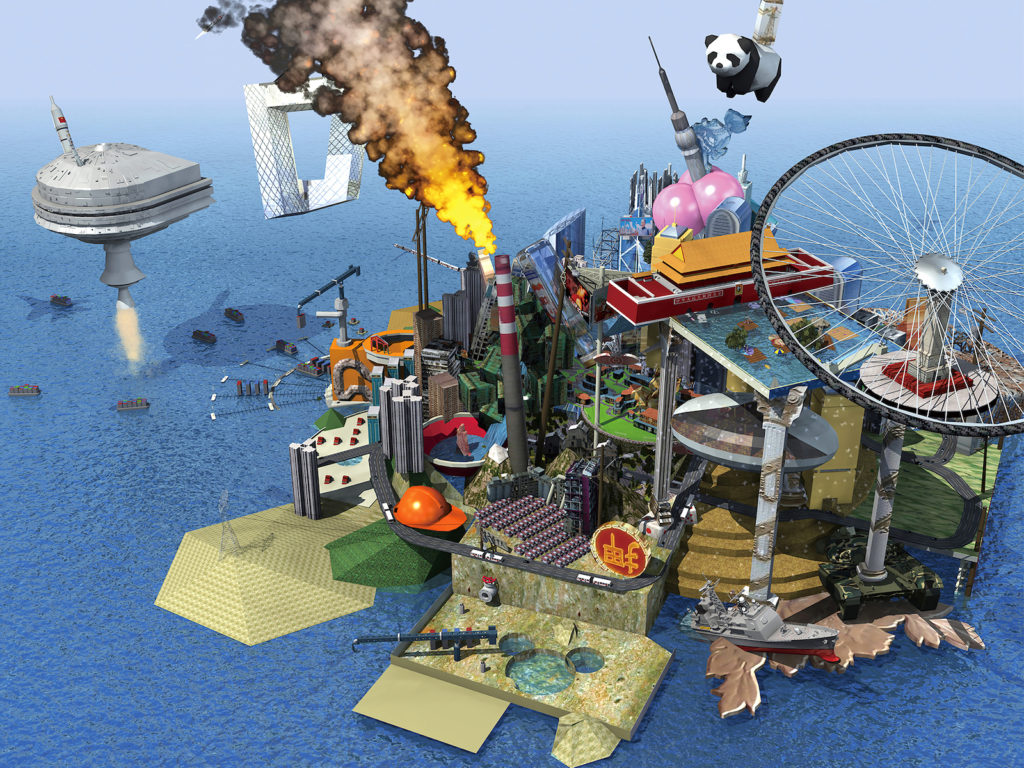
Photo: Courtesy the artist, Vitamin Creative Space and Sprüth Magers
Like today, everybody online uses Zoom and different social media. I think Second Life was quite early as a way to get to the future. So, I wanted to use RMB City as a small experiment, like a small sample laboratory, a laboratory to make a city, get people inside the city to produce activities, in order to see how people would have their new life in this RMB City. We invited artists, architects and musicians to carry out different activities in the city.
We introduced a museum into the city, we give a state museum. I think at that time I was very utopian; I wanted to change the world, using this online platform to build our future model. I think this was the very beginning idea for RMB City. This was the planning period in 2007. Then we spent half a year building the city. We ran the city until 2012, so it’s almost a five-year online project. I changed my role to something like a boss of the city—running the city, directing the people to work for me, to maintain the city. We selected a mayor every three months, a mayor to direct the city. It’s not an artist’s job … you become a boss, so it was quite crazy during those five years.
BL. Then you went on to something different. There’s a sense of horror that permeated your 2014 work LA Town. It’s a stop action animation depicting a mythical metropolis, a tabletop, make-believe city built from maquettes and miniature models or figures. You created a nightclub, a gas station, a supermarket, even a cinema playing the 1939 film ‘Gone with the Wind. Scattered around the set are figurines that make up the town’s inhabitants, who seemingly together act out a descent into an unrestrained modernized chaos, infused with violence. So, it’s a city destroyed by unknown forces. I was curious, in the credits you acknowledge the influence of the 1959 film Hiroshima Mon Amour. What other films have inspired you and what do you look for in a great film?
CF. Many people call it “L.A. Town” but actually it’s La Town, because if you look at the film, the dialogue is in French. And also, … “la” is like la biennale, right?… I don’t want people feeling that this is a Chinese video, or talk about China … I want to change the identity or confuse the identity of this piece. I think why I made this work, it’s because if you look at Whose Utopia?, which I finished in 2012, in 2014 La Town is totally going in a dystopian way. I think the reason is because at that time, Beijing had very serious pollution in the city. Also, after 2008, the economic crash affected the world and even affected China a lot.
So, everything is as if frozen. It’s not like RMB City, it’s a totally different time. It’s after the 2008 Chinese Olympics, which is like a line cutting the two periods. La Town I think started from there. It’s what I felt existed in the world; it was all about the horror, the terror … it’s something like today, right? In the La Town film, everybody is at home having their normal life … having dinner, having sex, they have baby food on the floor, but outside it’s full of rough things. So, I think … La Town is something significant, like my sixth sense … it’s about the world; how we may be going towards the end of the world. Maybe we are on the process … we step into this horrific, emergent timing. Yeah, I think La Town is all about this.
BL. We’ll move on now to your most recent work and I have to say I’m very, very sad that Covid-19 has kept me from seeing your survey that opened last March at the Serpentine in London. My hope is that when the world reopens and we can travel freely, that the Serpentine will have extended your show. Because I haven’t seen it, I would love to know what you did with this new work in VR; The Eternal Wave, which you created specifically for the Serpentine. I understand that actually, for the two new works in the Serpentine show, you spent more than two years with a great team of young artists, working in your studio. Please tell me something about The Eternal Wave, especially what’s going on in the work.
CF. For the VR piece, we worked with Acute Art, a VR studio based in London. And the VR work, Eternal Wave, is part of another long-term art project … lasting five years, begun in 2015, and also focused on Beijing. Because in 2015 my old studio was demolished, also because of urban planning. This is a very normal situation in China; every year artists’ studios are demolished by the government. So, I moved into an old cinema. The old cinema was built at the end of 1950. Because the cinema is in what we call the red zone in China, the government will demolish the buildings in the red zone. But because they argued with the local people in the community, they took a long, long time and didn’t demolish the building. But in the end had to demolish it. For almost twenty years, they couldn’t demolish it, because the local people argued that it was highly prized, because the value of the land is rising every year. So that’s how I got the chance to rent this cinema for five years to do my research.
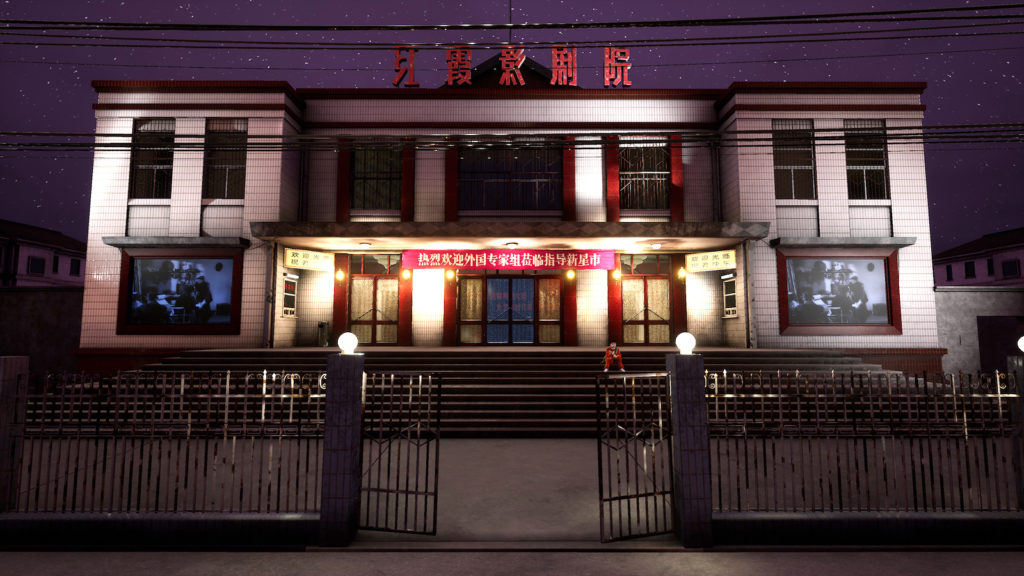
Virtual reality. Produced in collaboration with Acute Art
Photo: Courtesy the artist, Acute Art, Vitamin Creative Space, and Sprüth Magers
When I saw this cinema, I thought “Oh, even though I know it will be demolished one day, never mind. I’ll get into the cinema, and then I can have fantastic experience as an artist working in a cinema.” The most important thing I discovered is that the cinema was a government company’s cinema. The cinema was built for the employees who worked for the government factory. It’s another factory project of mine. The government factory did work for the ministry [the former Fourth Ministry of Machine Building of the PRC], for the army. They produced the first computers and satellites in China, even the first bomb in China. So, this cinema’s intended function was for this factory.
I spent five years interviewing local people, digging into the history behind the cinema, and digging into the history of computer technology in China. No official books talk about the development of the Chinese computer, because after the open policy, all the IBM, Dell, and Apple computers came in, and Chinese computer was going down. It disappeared; nobody remembered. The people are gone, the factory was finished at the end of the eighties. So, the project is really bringing back this Chinese computer storyline, and how it was born during the Cold War, since 1950. And was supported by Russia, because Russia and America have the Cold War at that moment, in 1950, 1960. And Russia supports the Chinese, because China is a communist country. It’s like a brother, a little brother… that supports the revolution and built the new China. Then China and Russia have ten years of marriage, of Russia giving all the support, even the technological support to develop the first computer.
And then I also did research about the friendship of Russia and China, and how they built up the first computer. So, this project is big … it’s huge, even about China’s history of the 1960s. Then I came up with a two-hour long film and one VR piece and a five-hundred-page publication that will maybe come out next month. It’s a big book that covers the whole project. We invited a Chinese science fiction writer, who wrote a story; we invited a pair of American scholars who research the relationship between Russia and China; it’s an American professor couple who are doing the research about this field. So yes, it’s a very rich book, a rich project. Because of the VR work, this is a Chinese computer project. I really wanted to use new technology to talk about this old story. It’s more like sci-fi; it’s about time travel. How to, from the exhibition side, travel to the 1950 cinema in China and to the computer laboratory, and watch the love story between Russia and China.
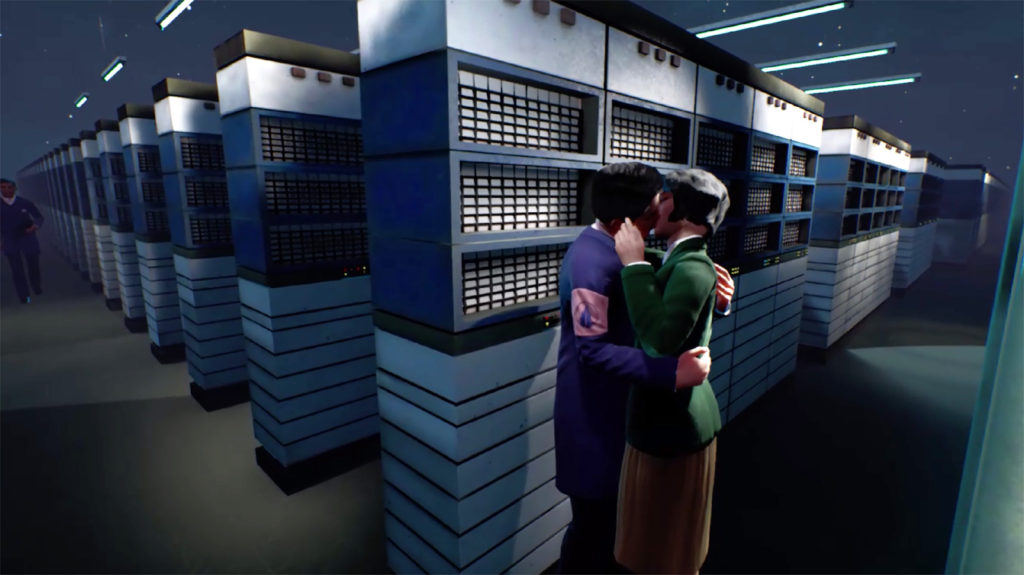
Virtual reality. Produced in collaboration with Acute Art
Photo: Courtesy the artist, Acute Art, Vitamin Creative Space, and Sprüth Magers
It’s a ten-minute VR experience, because I always wanted to expand or mix virtual reality and film and even theater. You put on the headset but you are in Beijing, you are in the old time, you meet all the old styles of computers, the first computer in China, and you observe the changing of the world. You have to see it and then you can get a lot of feelings about this VR piece.
I think the most different thing is … because I have a film background and a theater performance background, I mix all of this in the VR and make it interact more with the audience. And also the film is in motion, because the VR is not easy to have in motion and make people have the same emotion at the same time like a film, but this will. I think we made it.
BL. So, there’s very parallel content in the VR and the film. I watched the film yesterday, so there’s of course the love story, between the Chinese man working in the factory, the Russian specialist woman, and their attraction. Then there’s a very moving, poignant relationship between the father and the son and the son ends up in “the ether” or in this other domain, and there’s a hunger on the son’s part for the father. He’s very alone, although he encounters various characters, so it’s a complex story.
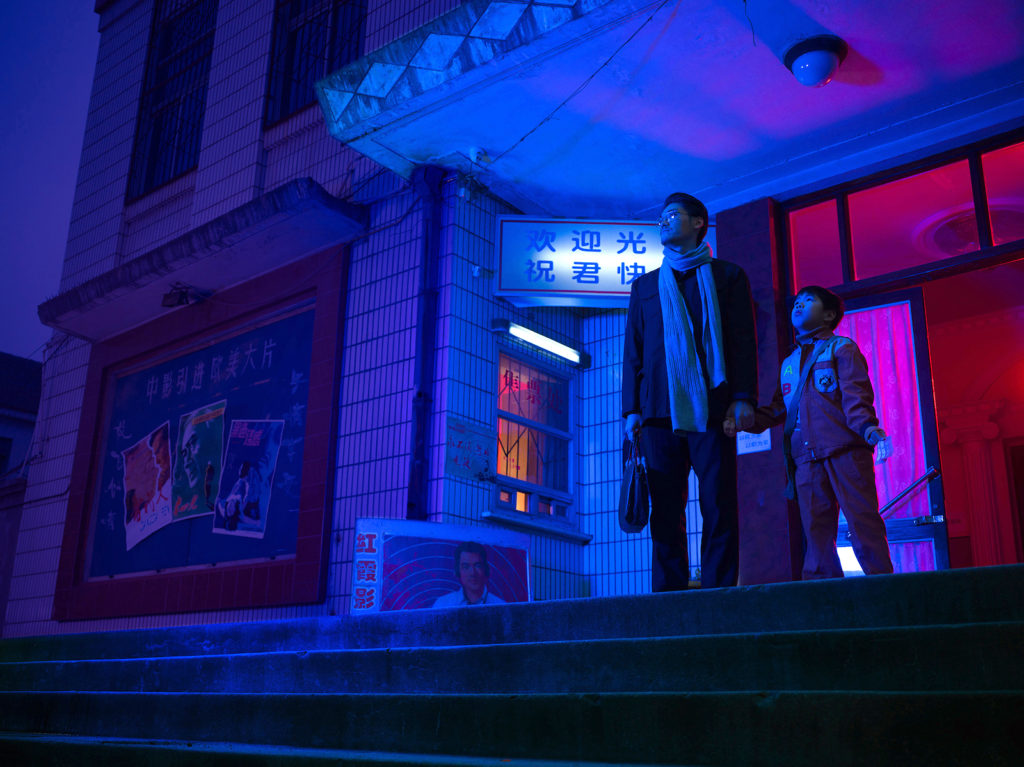
Single channel video (color, 6.1 sound, 110:64 min.)
Photo and video: Courtesy of the artist, Vitamin Creative Space and Sprüth Magers
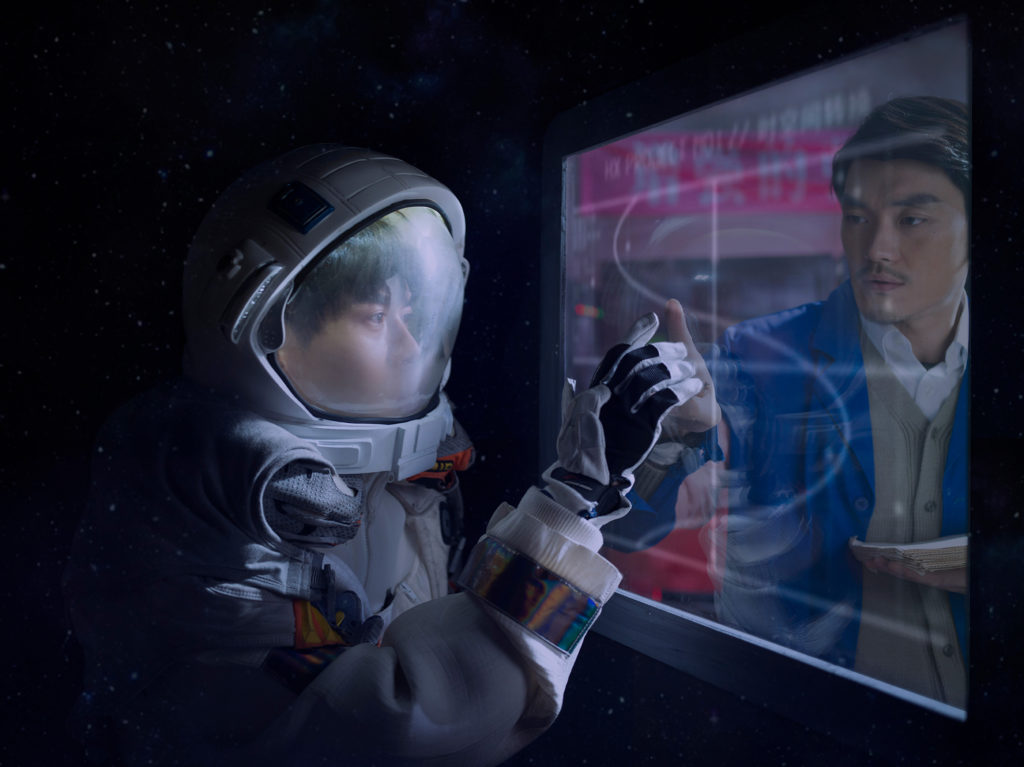
Single channel video (color, 6.1 sound, 110:64 min.)
Photo and video: Courtesy of the artist, Vitamin Creative Space and Sprüth Magers
Video: https://vimeo.com/401365696
Cao Fei – Nova (2019) – Excerpt 2’13 from Sprüth Magers on Vimeo.
CF. Yeah, it is.
BL. Did you develop the story with a team? It’s an amazing project that you did.
CF. We did the research first. We took three years, even four years to do the research about history. Then I wrote the script by myself. We have a big team, almost a professional film team who work on the shooting of the film. The little son is my son, so I put my son in the computer. In the film, they live in a city called “Nova” … “Nova City”. I’ve built a lot of cities … like RMB City, like La Town. I always fictionalize a city, but this story is more about going back to history.
If you look at many of my works, they’re about the contemporary. Even the factory [Whose Utopia?], or Meishi Street, and even the Cosplayers is about contemporary life and also about contemporary conditions. But this project is my first time to exactly go back into history, to dig into the history, to capture the communist era factory and the cinema before being demolished. I digitized the entire cinema in both the film and in the VR. We scanned the whole cinema and created a database, and then put it into the VR world, because I knew that the cinema will be demolished.
One day the whole area will be taken down, but we will still have this place in the artwork. It’s like Whose Utopia?, the factory is already gone. There’s no more Siemens factory. A lot of American business is gone; moved to Philippines, moved to Vietnam, now there’s nobody. The time is changed and also the society is changed. I think many of my works really document the changing of society.
BL. Very beautiful, so only two more questions. You’ve said that your father’s work has had a great influence on you, and that you see your practices as two narrative paths that are in tandem. You’re one step to the side of fantasy, he’s one step to the side of reality, but you both are approaching the same thing. What do you mean by that?
CF. Because my father is a government sculptor, he’s building all of these government figures, leaders for the public space or museum. It’s mainstream. You look at today, Americans, they take down a lot of sculpture. So, I can see that my father and I are both artists. My father tries to build up something; some utopia … communism’s utopia model. I don’t know if he wished to do it, or he was forced to do it, or he had to do it. But I’m the next generation from him; I can see the hope. I even talk about society changing. My father documenting a different leader also is society changing, history changing, so we’re in the same way documenting the changing.
BL. This is my last question, and it’s one that I’m asking every guest in “Barbara London Calling.” Do you consider yourself a media artist?
CF. If I have to select, I prefer “artist” or “multimedia artist.” Because every time I use media, I have to select the good media for the project. Like some topics have to use performance and some have to use film. So I prefer not to just be a “media artist,” because I just use media as a medium. But I [care] more about media as to what my works are.
BL. And to carry out your ideas. You have great ideas.
CF. Thank you.
This conversation was recorded June 26, 2020; it has been edited for length and clarity.
Support for Barbara London Calling is generously provided by Bobbie Foshay and Independent Curators International, in conjunction with their upcoming exhibition, “Seeing Sound,” which I curated. Be sure to like and subscribe so you can keep up with all the latest episodes. Follow up on Instagram @Barbara_London_Calling and check out BarbaraLondon.net for transcripts of each episode and links to the works discussed.
Barbara London Calling is produced by Bower Blue with lead producer Ryan Leahey and audio engineer Amar Ibrahim. Special thanks to Le Tigre for graciously providing our music. Thanks again for joining us. We’ll see you next time.
Images & Video
Born 1978 in Guangzhou, Cao Fei is a Beijing-based artist interested in how the virtual world contradicts and coincides with reality. Working across film, digital media, photography, sculpture, installation and performance, her starting point is China and how people—especially young people—navigate the rapidly changing social and technological landscape.

Photo: Courtesy of the artists, Vitamin Creative Space, and Sprüth Magers

Photo: Courtesy of the artists, Vitamin Creative Space, and Sprüth Magers

The San Yuan Li Project is a documentary about the history and changing landscape of a rural village swallowed up by the developing city of Guangzhou. The artists looked at the paradox of China’s rapid economic growth and progression of social marginalization. In a city of twelve million inhabitants, the San Yuan Li villagers find themselves moving to a different rhythm, living on subsistence farming and traditional crafts. They reinvent their traditional lifestyle by tending rice paddies on empty city lots and raising chickens on makeshift rooftop coops.

Meishi Street. 2006. Video (color, sound, 85 min.)
Photo and video: Courtesy the artists

Single channel video (color, sound, 9:12 min.)
Photo: Courtesy the artist, Vitamin Creative Space and Sprüth Magers

Single channel video (color, sound, 9:12 min.)
Photo: Courtesy the artist, Vitamin Creative Space and Sprüth Magers
Cao Fei – Cosplayers (Trailer), 2004 from Sprüth Magers on Vimeo.
Engaging with a community of anime (animation) devotees, Cao Fei observed how the fans dressed as idealized characters from Japanese movies and comics, and documented them standing amid an incongruous industrial backdrop. Her cinematic work shows how COSPLAYERS, dressed as game characters, imagine that their costumes will grant magical power, and enable them to transcend reality and arise above all worldly and mundane concerns.

Single channel video (color, sound, 20:20 min).
Photo: Courtesy the artist, Vitamin Creative Space and Sprüth Magers

During a six-month residency at the OSRAM lighting factory in Foshan, an industrial city outside Guangzhou, Cao Fei was able to film daily activities at the factory, highlighting the mechanized tasks performed by employees. She interviewed the workers, and then, based on their responses, collaborated with them to develop moving performances. In costumes or street clothes, individuals dance and play music, while others continue to work around them.
Cao Fei noted, “Factories…are not a creative industrial park or a Google office. Factories are cold production lines and large machines; they are pipelined environments. They are clean, tidy [and inhuman], with no extra trace of garbage, filled with tired people who repeat the same work, day after day. In multinational groups, they are corporate systems—refined management and corporate culture inspires the staff to a certain extent, so they will not fall into desperate spirits.”

Photo: Courtesy the artist, Vitamin Creative Space and Sprüth Magers
Cao Fei moved deep into the virtual world, spending eight hours a day in the online realm of Second Life. She described it as “a condensed incarnation of contemporary Chinese cities…and a rough hybrid of communism, socialism, and capitalism realized in a globalized digital sphere combining overabundant symbols of Chinese reality with cursory imaginings of the country’s future.” Opened to the online public in 2009 and maintained until 2011, RMB City attracted users from all over who enjoyed its events, which included artist projects, contests, and even mayoral inaugurations. A lively experiment in urban planning, Cao Fei’s project tested the relationship between the virtual and the real.
La Town. 2014. Video (color, sound, 35 min.)
Courtesy the artist, Acute Art, Vitamin Creative Space, and Sprüth Magers

Virtual reality. Produced in collaboration with Acute Art
Photo: Courtesy the artist, Acute Art, Vitamin Creative Space, and Sprüth Magers

Virtual reality. Produced in collaboration with Acute Art
Photo: Courtesy the artist, Acute Art, Vitamin Creative Space, and Sprüth Magers
The artist has noted that each time she works with virtual reality, the technology isn’t the same, the team isn’t the same, nor is her concept. This makes a new VR work feel like a newborn. The Eternal Wave begins with the viewer standing in a physical reproduction of the actual kitchen in the artist’s Beijing studio, located in Beijing’s former Hongxia Cinema. Becoming immersed in the virtual version of her kitchen, the user is drawn into the artist’s creative universe, and acts out a role in the artist’s production. Cao Fei seeks to re-explore and re-imagine the past, reflecting the changing nature of humanity. She has noted that virtual reality hardly reaches the level of empathy provided by cinema. She is interested in expanding VR’s boundary, to look beyond beauty, astonishment, and the ability to interact. She’s interested in virtual reality as agitprop, and whether or not it can disrupt experience as we know it. “How will VR change our memories, our dreams?”

Single channel video (color, 6.1 sound, 110:64 min.)
Photo and video: Courtesy of the artist, Vitamin Creative Space and Sprüth Magers

Single channel video (color, 6.1 sound, 110:64 min.)
Photo and video: Courtesy of the artist, Vitamin Creative Space and Sprüth Magers
Cao Fei – Nova (2019) – Excerpt 2’13 from Serpentine Gallery.
Cao Fei’s film Nova considers the development of China’s first computers. For the work, she reconstructed the foyer and kitchen of Beijing’s Hongxia Cinema, built in the 1950s. Back then the cinema’s audience consisted mostly of computer workers from the nearby factory. Her reconstruction effort wasn’t about ordering and archiving things. Rather, she “built a circus on top of the ruins, raised the curtain, and did some magic tricks.” Her studio has been housed in this old theater. She has said that at the end of the day, it doesn’t matter that we’ll never get to know the truth, including the historical truth. We can only look for its traces.
